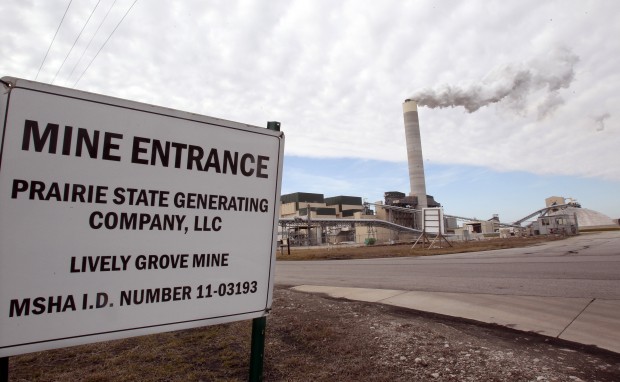Don’t you hate it when you’re quoted a price for a new car over the phone or online, but when you get to the dealership they inform you the price is actually hundreds (or even thousands) of dollars more than they said it would be? Imagine how you’d feel if the price was millions or even billions of dollars more.
That’s how 234 municipalities and electric cooperatives in the Midwest are starting to feel as they find out about the true cost of the coal-fired Prairie State Energy Campus in Washington County, Illinois, which is reportedly more than $3 billion over budget.
Prairie State Coal Plant: A $5 billion money pit
In 2004, Prairie State was marketed by Peabody Energy, the nation’s largest coal company, as a cheap source of power.
The 1600 MW project, which comprises two units, was originally scheduled to come online in mid-2012 and cost $1.8 billion. Based on that estimate, entities representing municipalities and electric cooperatives in eight states — Illinois, Indiana, Kentucky, Michigan, Missouri, Ohio, Virginia, and West Virginia — lined up to sign long-term power purchase agreements with the project’s developers.
Unit 1 began operating earlier this summer while unit 2 may not be finished until sometime next year. Meanwhile, the total cost of the project has soared to almost $5 billion and these utilities — and their customers — are on the hook to pay it.
A new report by the Institute for Energy Economics and Financial Analysis (IEEFA), “The Prairie State Coal Plant: The Reality vs. the Promise,” finds that the $3 billion increase in the estimated cost of the project could result in a 40 to 100 percent increase in the price of power compared to initial projections. This would mean higher electric bills for 2.5 million electricity customers in eight states. The biggest loser could be American Municipal Power, Inc. (AMP), headquartered in Ohio, which bought a significant share of Peabody’s interest in the plant on behalf of its members in 2007, along with other utilities in the region.
Many of the contracts Peabody Energy signed with AMP and other utilities were “take-or-pay” contracts. What that essentially means is that they agreed to take a certain amount of power and pay for it over the life of the plant. The bad news is that many of these contracts were structured so that virtually all construction cost overruns can simply be passed through, no matter how egregious. To make matters worse, even if the plant doesn’t get finished these utilities will STILL have to pay for it.
Is Vogtle the next Prairie State?
Unfortunately, Midwestern utilities may not be the only ones to wake up with a case of buyer’s remorse. As I noted in an earlier blog, the current crop of new nuclear reactors under construction in the Southeast are all well over budget and behind schedule. This should surprise no one given the industry’s long history of cost overruns, cancellations, and delays.
The Vogtle 3&4 nuclear project in Georgia — a (now) $15 billion project supported by multiple utilities with long-term take-or-pay contracts — is showing schedule delays and cost overruns similar to Prairie State. Earlier this summer, Southern Company, whose Georgia Power subsidiary owns almost half of the plant, revealed that the project was $950 million over budget. But despite warnings of cost overruns and delays, the Georgia Public Service Commission (PSC) recently decided to approve and pass onto Georgia Power’s customers all costs incurred by the utility through December 2011. That decision came just over a year after PSC staff withdrew a proposal to link any increases in the reactors’ budget to Georgia Power’s profits after it was loudly trashed by the utility.
Similar to AMP’s arrangement with Prairie State, the Municipal Electric Authority of Georgia (MEAG Power) owns about 23 percent of Vogtle. Fitch Ratings gave the debt MEAG issued to finance Vogtle high ratings because it is supported by take-or-pay contracts covering the life of the plant. In particular, Fitch awarded so-called Project M bonds an A+ rating that “reflects the contracts and credit fundamentals of MEAG Power and the power sales contracts with its 29 Project M participating member systems (through 2058) [emphasis added].” In other words, MEAG and its member systems are on the hook to pay for Vogtle, regardless of cost, for the next 46 years.
It’s not too late to keep some utility customers from paying for bad management decisions
When you get a price from a car dealership that doesn’t line up with its online offer, you can always walk out or negotiate a better price. By contrast, the utilities that signed long-term take-or-pay purchase agreements with Prairie State can’t simply walk out. Their contracts obligate them to buy power from the plant for decades regardless of cost and these costs will be passed onto their customers. They can take it to court, but that’s a long and painful process and the outcome is uncertain. In the meantime, these utilities will pass these costs onto their customers. The question is not whether their rates will rise, but rather how much.
MEAG and the many utilities that signed long-term take-or-pay contracts for power from Vogtle 3&4 could also be facing sticker shock in the not-too-distant future, and most likely they will not be able to walk away. However, there is still time for Georgia regulators to protect Georgia Power customers by demanding that the utility bear (at least some of) the risks of cost overruns at the plant. The PSC should act now to prevent this entirely predictable travesty from playing out to its logical conclusion. Otherwise, Georgia Power customers could be stuck with high electricity bills for decades to come.
Caveat emptor.

